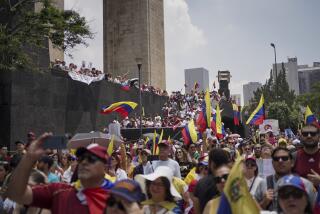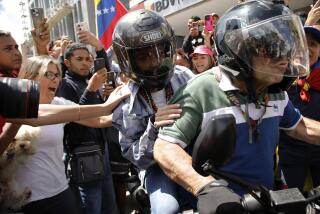In Iran, rival factions rally after days of unrest
TEHRAN — Pressing their claim to victory, pro-government supporters staged a mass rally in Tehran on Tuesday, responding to calls from state media to come out in support of President Mahmoud Ahmadinejad and against protesters they described as “looters and arsonists.”
But Ahmadinejad’s opponents defied and outwitted authorities to organize another mass rally of their own. Filing silently through the city’s main boulevard, they held flowers and green banners, ribbons and posters of Mir-Hossein Mousavi, the former prime minister who lost his bid for the presidency Friday in a vote marred by allegations of fraud.
The dueling rallies illustrated efforts by both sides to seek the stamp of legitimacy by drawing huge numbers of people onto the streets. They also highlighted the contrast between Mousavi supporters’ technical savvy and the old guard’s blunt instruments of state.
The disputed presidential election results, which Mousavi and his supporters say were forged, have sparked four days of civil unrest, the most momentous since the student uprisings of 1999.
The country’s Guardian Council, a 12-man committee that serves to uphold the constitution, announced Tuesday that it had begun a 10-day investigation into allegations of voting irregularities, but also praised the election process and said the reevaluation would be limited to specific areas where alleged infractions took place.
“From the point of view of violations, it was an election that had the least amount of violations reported,” said Abbas-Ali Kadkhodai, a spokesman for the council, according to state television.
The country’s supreme leader, Ayatollah Ali Khamenei, beseeched Iranians to draw back from the divisions created over the election. At least 12 people have been killed in clashes between pro-government militias and protesters in the capital of 12 million. One was shot and wounded after an altercation at the end of Tuesday’s largely peaceful north Tehran rally, according to a witness. A source inside the capital’s Evin Prison said upward of 1,500 people, mostly young men, have been arrested during the clashes and roughed up in prison before being let go with warnings.
Among dissidents reported arrested Tuesday were Mohammad Ali Abtahi, a prominent reformist cleric and blogger, and Abdolfattah Soltani, a human rights lawyer.
“Assuming that there are 24 million people on one side and 14 million people on the other side is a big mistake,” Khamenei was quoted as saying by state television in reference to the official vote totals. “This is because those who voted for the elected president and other candidates all equally believe in [the] Islamic system.”
The pillars of the establishment appeared to be rallying behind Ahmadinejad, who spent much of the day in Russia, where he appeared with Russian President Dmitry Medvedev on his first international trip since his reelection.
Parliamentary speaker Ali Larijani, a prominent conservative, is a rival of Ahmadinejad but, nevertheless, appeared on television addressing lawmakers and urging the nation to get behind the president. He blamed foreigners for the recent days of unrest.
Meanwhile, Ayatollah Hossein Ali Montazeri, Iran’s leading dissident cleric, who is closely monitored by authorities in his home in the shrine city of Qom, issued a statement calling for three days of mourning starting today to commemorate the deaths of those killed in the clashes.
The supreme leader’s brother, reformist cleric Hadi Khamenei, called for an impartial, independent commission made up of representatives from numerous branches of government and all the opposition candidates, according to the Mehr news agency.
Western reporters have been asked to stay away from unauthorized protests. Official news sources offer little information about unrest elsewhere in Iran, a nation of 70 million.
Protesters have uploaded video to YouTube purporting to show unauthorized demonstrations against the election results and Ahmadinejad in Esfahan, Shiraz, Tabriz and other cities.
Tuesday’s two main rallies illustrated both the dynamic political jostling underway in Iran as well as the contrasts between the two camps.
Mousavi had called for a demonstration at 5 p.m. in Tehran’s Vali Asr Square, but pro-government loyalists outmaneuvered him, calling for a massive 4 p.m. rally at the same location. Television stations began heavily promoting the pro-government rally on state-controlled TV and radio, urging Ahmadinejad supporters to show up in force as a display of popular support for the president and against “looters and arsonists.”
Mousavi, who attended the Monday rally at Azadi (Freedom) Square, but who one source said remains under security restrictions, sought to cancel the rally and called upon his supporters to stay away.
According to witnesses, many of the placards and slogans at the pro-government rally were in support of Khamenei rather than Ahmadinejad. They denounced Israel and the U.S., frequent rallying cries among the large crowds that attend the main Friday prayer sermons in Tehran and the annual celebrations commemorating the 1979 Islamic Revolution.
“This nation will protect and defend its revolution,” Gholam-Ali Haddad-Adel, an Ahmadinejad supporter, told the crowd, which numbered more than 100,000, not nearly as dramatic as the massive unauthorized opposition demonstration that took place a day earlier in Freedom Square.
But pro-Mousavi demonstrators managed to overcome cellphone outages and blocked social networking websites to use word of mouth, e-mail, text messaging and pay phones to quickly spread the word and organize a huge silent march in north Tehran.
According to witnesses, the protest grew as the evening wore on to include at least tens of thousands, stretching from Vanak Square to Tajrish Square at the foothills of the Alborz Mountains. Tehran residents said they flowed into Vali Asr from all parts of the city to join in the mostly peaceful gathering.
They held up placards reading “Silence!” and snapped photos of one another with cellphone cameras, according to witnesses and footage broadcast on international satellite news channels. They spread the word for another rally today in Tehran’s 7th Tir Square.
“This silence is a protest to the ruling establishment,” one man said.
Many of the young men wore black shirts to honor five students reportedly killed in the dormitories of Tehran University by pro-government Basiji militiamen Sunday night, according to a witness.
Mousavi was nowhere to be seen. A source in contact with his confidants said he and his outspoken wife, Zahra Rahnavard, were being kept under close supervision in their Tehran home, with restricted access to the Internet and telephones. Many of his supporters say they regard him as a “temporary” leader to rally around.
“I am happy that Mousavi was not elected as president,” said Ershad, 21, a student of industrial engineering, who was walking along Vali Asr Street south of the rally, which he said he had just attended. “If he were, he would have been just another Khatami,” the reformist President Mohammad Khatami, who tried and failed to open Iran’s political system beginning in the late 1990s.
“Now the gap within the system widens and the process of de-legitimization begins,” he said, asking that his last name not be published. “Many are increasingly disillusioned about the system.”
As night fell, neighborhoods erupted in a mix of voices, residents climbing to their rooftops and chanting “God is Great!” and “Death to the dictator,” in what has become a nightly ritual of protest, growing louder and more explicitly political each day.
“If this fades, little by little, which is highly possible,” said Akbar Hassani, who is in his 20s, “it will be like fire buried under ash, and some other time it will reappear.”
--
Mostaghim is a special correspondent.
More to Read
Sign up for Essential California
The most important California stories and recommendations in your inbox every morning.
You may occasionally receive promotional content from the Los Angeles Times.










